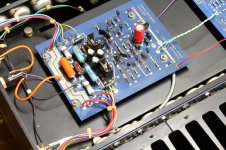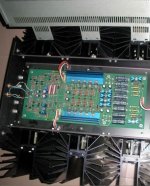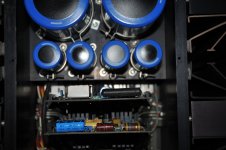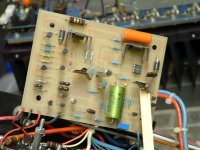Not hindered by any knowledge I almost ten years ago started a thread with the title:
'Why Class A? Wasting power is something of the past'
Well that wasn't a good start to make myself very popular around here because quite a few members and designers are conviced that this is still the way to go to have a good sounding amplifier and they're probably right.
Another thing that bothers me is the following:
The sound of an amplifier is the sum of a couple culminating factors I reckon apart from the rest of your soundsystem.
For the sake of the argument let's say we have a device with a proper designed powersupply, high quality input- and outputconnectors, proper layout and decent further hardware. Let say Threshold S/500.
The materialized creative thinking/solution/design is housed in the front-end circuitry of the amp. In case of the amplifiers from Nelson Pass (Threshold and PassLabs) this circuitry has its own PCB like the picture of a Stasis 1 where you can clearly see that frontendboard.
It seems to me that the circuitry on that board is the most determining factor how that amplifier sounds under the assumption that the rest of the amplifier is proper designed.
Especially the Threshold and Passlabs designs is very consistent in having exactly the same frontend (in a given range of course) with from the smallest model like a Threshold S/150 or Passlabs X150.8 basically increasing powersupplies and output devices. Even the Threshold SA or Passlabs XA differ only in having a lower railvoltage and higher biasing but have the same hardware as their S and X cousins.
It's very rational to have such a line-up because you only have to determine what's the SPL in dB's you want to have in your listening environment, the efficiency of your speaker (and impedance curve maybe) and then you can choose the amp (and the amps😉 and output voltage) you need to match your desire. It's a bless for the amplifierbuilder too because this modular approach is easier to built and you can have many standard parts.
It's a principle that's implemented by many other amplifierbuilders like Krell for example.
My question is this:
With the sound reasoning (sounds sound to me 😀) above in mind, how can so many reviewers find differences in sound between the different models of a given productrange while the dominant factor is the design molded in the same frontendboard that is in all the models.
With Threshold and Krell one hears often that the smallest amplifiers (The SA/3, SA/3.9E or Krell KSA-50) is absolute the best sounding or even the preferred ampifier by the designer himself (Yes when you have a horn loudspeaker with a efficiency of more than 100 dB/1 watt/1meter). I find that strange and cannot explain these statements.
Did I miss a another determining factor in amplifier design?
http://www.diyaudio.com/forums/attachment.php?attachmentid=594361&stc=1&d=1485275098
'Why Class A? Wasting power is something of the past'
Well that wasn't a good start to make myself very popular around here because quite a few members and designers are conviced that this is still the way to go to have a good sounding amplifier and they're probably right.
Another thing that bothers me is the following:
The sound of an amplifier is the sum of a couple culminating factors I reckon apart from the rest of your soundsystem.
For the sake of the argument let's say we have a device with a proper designed powersupply, high quality input- and outputconnectors, proper layout and decent further hardware. Let say Threshold S/500.
The materialized creative thinking/solution/design is housed in the front-end circuitry of the amp. In case of the amplifiers from Nelson Pass (Threshold and PassLabs) this circuitry has its own PCB like the picture of a Stasis 1 where you can clearly see that frontendboard.
It seems to me that the circuitry on that board is the most determining factor how that amplifier sounds under the assumption that the rest of the amplifier is proper designed.
Especially the Threshold and Passlabs designs is very consistent in having exactly the same frontend (in a given range of course) with from the smallest model like a Threshold S/150 or Passlabs X150.8 basically increasing powersupplies and output devices. Even the Threshold SA or Passlabs XA differ only in having a lower railvoltage and higher biasing but have the same hardware as their S and X cousins.
It's very rational to have such a line-up because you only have to determine what's the SPL in dB's you want to have in your listening environment, the efficiency of your speaker (and impedance curve maybe) and then you can choose the amp (and the amps😉 and output voltage) you need to match your desire. It's a bless for the amplifierbuilder too because this modular approach is easier to built and you can have many standard parts.
It's a principle that's implemented by many other amplifierbuilders like Krell for example.
My question is this:
With the sound reasoning (sounds sound to me 😀) above in mind, how can so many reviewers find differences in sound between the different models of a given productrange while the dominant factor is the design molded in the same frontendboard that is in all the models.
With Threshold and Krell one hears often that the smallest amplifiers (The SA/3, SA/3.9E or Krell KSA-50) is absolute the best sounding or even the preferred ampifier by the designer himself (Yes when you have a horn loudspeaker with a efficiency of more than 100 dB/1 watt/1meter). I find that strange and cannot explain these statements.
Did I miss a another determining factor in amplifier design?
http://www.diyaudio.com/forums/attachment.php?attachmentid=594361&stc=1&d=1485275098
Attachments
Are you serious or just Trollbaiting? This thread could run for 100 pages based on previous ones exactly the same without any conclusion
Robert your conclusions are based on a single unfounded assumption namely that the frontend determines the sound. Thus your conclusions are also unfounded. Sorry.
Jan
Jan
Are you serious or just Trollbaiting? This thread could run for 100 pages based on previous ones exactly the same without any conclusion
No, I'm deadserious!
If you are convinced as a designer that you have designed a very good amplifier, nobody will ask the question which transformer, large can capacitors, bridge rectifier, output devices, cooling fins etc.. did you use, but the central issue would be to my knowledge the front-end circuitry.
It's the concept that's marketed this way that you have the same quality but with more or less power, thus with more or less output devices, moere or less powersupply, more or less coolingfins.
It's rational in my mind.
So if you are convinced as a designer that you have a good design you will implement it in all your amplifiers untill you come up with an update and you call it a Series II or Mark 2 or .5 or .8 or whatever that designates it as a bettered version. If the frontend is on its own board you can swap boards and you have the updated version. The rest of the hardware stays the same basically.
Perhaps your "sound reasoning" is unsound? I assume, by the way, that what you curiously call the "frontendboard" is what others call the amplifier circuit, apart from the output devices which will usually be mounted elsewhere.RobertS61 said:With the sound reasoning (sounds sound to me ) above in mind, how can so many reviewers find differences in sound between the different models of a given productrange while the dominant factor is the design molded in the same frontendboard that is in all the models. . . I find that strange and cannot explain these statements.
Perhaps. Every decision in electronics has knock-on effects, second-order effects etc. You seem to ignore those.Did I miss a another determining factor in amplifier design?
Why would you think the front end is the determining portion? That is pretty much the very easiest to do (no thermal variation stress, small signal levels to deal with, lots of widebandwidth parts available at those levels, insiginificant power supply variations...). The output stage is where all (might) go to h***, IMO.
Of course, if you are going to go all-reasoning, maybe just buying one of many pre-built already-designed pro audio amps, and avoiding the nearly-always more expensive DIY approach altogether would seem more logical. Of course, then not a lot of reason to be visiting the solid-state forum of diyaudio!
Of course, if you are going to go all-reasoning, maybe just buying one of many pre-built already-designed pro audio amps, and avoiding the nearly-always more expensive DIY approach altogether would seem more logical. Of course, then not a lot of reason to be visiting the solid-state forum of diyaudio!
I thought frontend and board were common expressions in amplifier hardware semantics, but correct me if I'm wrong.Perhaps your "sound reasoning" is unsound? I assume, by the way, that what you curiously call the "frontendboard" is what others call the amplifier circuit, apart from the output devices which will usually be mounted elsewhere.
It's the board or PCB that carries the low level circuitry before it goes to the drivers/output devices.
I'll attach some more pics for you to illustrate what I mean.
http://www.diyaudio.com/forums/attachment.php?attachmentid=594395&stc=1&d=1485288071
http://www.diyaudio.com/forums/attachment.php?attachmentid=594396&stc=1&d=1485288071
http://www.diyaudio.com/forums/attachment.php?attachmentid=594397&stc=1&d=1485288071
Okay, please share it with me.Perhaps. Every decision in electronics has knock-on effects, second-order effects etc. You seem to ignore those.
Attachments
Of course, if you are going to go all-reasoning, maybe just buying one of many pre-built already-designed pro audio amps, and avoiding the nearly-always more expensive DIY approach altogether would seem more logical. Of course, then not a lot of reason to be visiting the solid-state forum of diyaudio!
No, I d not belong to the group of people that states that if an amplifier measures good, it must sound good. I'm really and honestly interested in the determining factors that makes an amp sound as it does.
My assumption is that the most important factor would be the lowlevel circuitry between the input and the output devices, the frontend. I derive this conclusion based on all the American poweramps I've seen in my life (50 or so) and the more expensive ones like the ML-2, No. 20 etc.. the Thresholds and PassLabs, lots of Krells had their frontendcircuitry on separate PCB's that were relatively easy to update. I do not claim that those manufacturers in fact updated their producst in this way, the ML-2 was never updated but the No. 20 was as the Thresholds went from Series I , to Series II and opticalbias with the powersupply, output devices remaining the same.
So I reckon if these well respected manufacturers found it necessary to update their amplifiers, in most cases a newly designed frontend (board) was enough to get you to a Series II, Mark 2, 20.5 or 20.6 etc.. X350.5 etc...
So I reasoned that the "heart" of the amplifier, the most dominant factor that determines the sound of it would have to be the frontend circuitry.
Even BJT vs MOSFETs sound different. Then lateral MOSFETs vs vertical MOSFETs sound different. Then there are power JFETs that sound different. Push pull complementary vs quasi-complimentary vs single ended output stages sound distinctly different. The harmonic distortion profile H2 vs H3 vs H4 vs higher orders all affect the perceived sound. The input stage is one part and he whole amp is another story.
No, I d not belong to the group of people that states that if an amplifier measures good, it must sound good. I'm really and honestly interested in the determining factors that makes an amp sound as it does.
I suggest then rather than make assumptions, do experiments. My own experiments have shown that the primary determiner of the sound of a poweramp is the amount of power supply noise making it into the output. Hence power supply impedance and PSRR are the major determinants.
Of course my listening wasn't done double blind so I'm not claiming any universal applicability of my results. They could possibly be down to placebo.
If you go by measurements, then an opamp like LME49990 is perfect. I mean, it has zero, zero,
... zero ...
... and more zeros...
... THD.
The only difference between such opamp and a competently designed power amp is output current and high voltage, ie output stage and subtleties like feedback compensation and such.
Therefore, I would be of the opinion that the juicy stuff happens in the output stage. And how compensation tackles output stage defects.
... zero ...
... and more zeros...
... THD.
The only difference between such opamp and a competently designed power amp is output current and high voltage, ie output stage and subtleties like feedback compensation and such.
Therefore, I would be of the opinion that the juicy stuff happens in the output stage. And how compensation tackles output stage defects.
I'm really and honestly interested in the determining factors that makes an amp sound as it does.
...
My assumption is that the most important factor would be the lowlevel circuitry between the input and the output devices, the frontend.
...
So I reasoned that the "heart" of the amplifier, the most dominant factor that determines the sound of it would have to be the frontend circuitry.
I disagree, there are profound sonic differences in the same output devices if connected common-source, common-drain, and that's before the differences of push-pull vs. single-ended.
That said, I believe you are seeing commonalities between amplifier models of the same manufacturer... If you have a great front-end, yes, you can attach many different variations of the output stage you choose to make a bigger or smaller amplifier to fit into your product line.
I'd love to have the opportunity to have you to my house and listen to a Pass F5 and a Pass Burning Amplifier BA-3. The Front end is essentially the same, the output stage is different, and in my builds, I have identical input and output transistors in both amps. It's not an exaggeration at all to say the BA-3 is a mini F5 driving a follower output stage. The sound difference is striking.
Your reasoning is flawed. The main PCB may be changed for a number of reasons:RobertS61 said:So I reckon if these well respected manufacturers found it necessary to update their amplifiers, in most cases a newly designed frontend (board) was enough to get you to a Series II, Mark 2, 20.5 or 20.6 etc.. X350.5 etc...
So I reasoned that the "heart" of the amplifier, the most dominant factor that determines the sound of it would have to be the frontend circuitry.
1. component no longer available, or price increase, or supply troubles
2. change in fashion (or merely a change in designer)
3. improvement in EMC performance (or some other statutory issue)
4. saving money by re-using the same PCB in different amplifier models
5. improvement in sound quality
Having made a change, for whatever reason, marketing then may add some spin.
...how can so many reviewers find differences in sound between the different models of a given product range while the dominant factor is the design molded in the same frontend board that is in all the models.
Different back-ends (i.e. "the rest of the amplifier") can't have different sonic signatures?
With Threshold and Krell one hears often that the smallest amplifiers (The SA/3, SA/3.9E or Krell KSA-50) is absolute the best sounding or even the preferred ampifier by the designer himself (Yes when you have a horn loudspeaker with a efficiency of more than 100 dB/1 watt/1meter).
Taste, and possibly the ability to afford very efficient and sensitive (i.e. expensive) speakers. Is this in any way paradoxical?
I disagree, there are profound sonic differences in the same output devices if connected common-source, common-drain, and that's before the differences of push-pull vs. single-ended.
Correct, these are also variations in the outputstage that will have a influence on the endresult.
That said, I believe you are seeing commonalities between amplifier models of the same manufacturer... If you have a great front-end, yes, you can attach many different variations of the output stage you choose to make a bigger or smaller amplifier to fit into your product line.
Yes that's what I basically stated. I did never said or imply that the only factor that would count would be the kind of frontend circuitry no matter what will follow. Of course I ment and stated that within a given range of amplifiers being the Threshold Stasis - or Krell KSA/KMA line, manufacturers themselves market their ranges as virtually identical soundwise only differentiating at the amount of outputpower. They all share the same frontendboard. Updates to Series II, Mk 2 etc.. comprise basically a new frontendboard with a different circuitry.
I do found my deduction legitimit that based on these statements the main difference within in given range of amplifiers is due to the circuitry materialized in the frontend. Furthermore in general a conclusion could be reached that the most dominant factor that shapes the sound of an amplifier in general is this frontendcircuitry because new designs like a Levinson No.20.5 and 20.6 etc.. are mostly restricted to new frontendboards and circuitry on it.
So. I'm not saying the rest of the amplifier hasn't any importance at all as some are implying here, that would be ridicule to state that, but the "heart" or the "brain" that evolved out of the mind of the designer, the creative process, is molded into the frontendcircuitry.
Let's face it, most outputsections of highend solidstate amplifiers have a complementary set of transducers with a stiff powersupply to keep the rails from sacking when the load halves. That means a serious transformer, lots of uF etc... those things that make an poweramplifier heavy. Yes I'm aware that there are other transducers then bipolars like Mosfets, Hexfets, IGBT's, VFets, Sits, triodes, pentodes. That there are single-ended outputstages like the Aleph range and SITS, solidstates with outputtransformers like the McIntosh and Sansui BA-5000 and so forth, but that's not relvant to my question.
I'm not challenging anybody to proof anything but ask if you (this DIY community) concur that within the outlined picture the most determining factor is the frontendcircuitry.
It's the creation (the circuitry) not the paint or canvas (parts) that makes a painting great, that moves you.
The design is the intellectual property, the manifest that can be patented.
A commonly heared statement within the audio community is that simple circuits tend to sound better than complex ones. So this is a discriminating factor that has been generally accepted.
There's no such agreement about the kind of output devices, powersupplies or specific parts. For every kind of transducer, outputstage or powersupply implemented in an amplifier, one can find examples that are sought after, that are cherished by their owners and are in high esteem generally.
For me that's another indication that it's the circuitry that matters the most.
That's very kind of you to invite me but there's an ocean between us ...🙂I'd love to have the opportunity to have you to my house and listen to a Pass F5 and a Pass Burning Amplifier BA-3. The Front end is essentially the same, the output stage is different, and in my builds, I have identical input and output transistors in both amps. It's not an exaggeration at all to say the BA-3 is a mini F5 driving a follower output stage. The sound difference is striking.
Which amp do you prefer?
The best that I heared from NP was his SIT-2 amp playing on the Avant Gardes of my longtime friend. We share together a passion for music playback systems for over thirty years now.
The fact that a statement is commonly heard within the audio community is not evidence that it is true. It is merely evidence that some people believe it to be true. Whether such a statement is "generally accepted" would depend on who accepts it, why, and who does not and why. Repetition is not a method of proof in science and maths, although it appears to be so in fashion and politics. Much of modern audio is fashion rather than science.RobertS61 said:A commonly heared statement within the audio community is that simple circuits tend to sound better than complex ones. So this is a discriminating factor that has been generally accepted.
Yes circuits matter the most; the circuit includes the output stage and may include the power supply. You cannot isolate one part of the circuit.For me that's another indication that it's the circuitry that matters the most.
The fact that a statement is commonly heard within the audio community is not evidence that it is true. It is merely evidence that some people believe it to be true. Whether such a statement is "generally accepted" would depend on who accepts it, why, and who does not and why. Repetition is not a method of proof in science and maths, although it appears to be so in fashion and politics. Much of modern audio is fashion rather than science.
Sure, but then any discussion can be flawed by merely a statement that there is no hard mathematical evidence to support your thesis.
Within sciencecommunity empirical data that can be repeated is also accepted as valid input for a theory.
Furthermore I was under the impression that this forum isn't about hard evidence. If that was the case solidstate devices with perfect specs on slew rate, THD, IM etc.. would reign but that isn't case as far as I can see.
Yes you can, I just did it and not bluntly but supported by arguments.Yes circuits matter the most; the circuit includes the output stage and may include the power supply. You cannot isolate one part of the circuit.
I'm not challenging anybody to proof anything but ask if you (this DIY community) concur that within the outlined picture the most determining factor is the frontendcircuitry.
I do not concur with that assessment. If I do not have to prove anything then you are asking for my opinion, which I am happy to expand upon;
In my opinion and limited experience the design/topology/parts need to work together to get the planned output. Is the front end important, and does it have a huge impact on the sound? Yes. No question of that. Is it everything? No.
Is your opinion that FE make all the difference a valid opinion? Yes! Most certainly! Please feel free to discuss, contrast, research, and engage in conversing about your opinion.
Which amp do you prefer?
The best that I heared from NP was his SIT-2 amp playing on the Avant Gardes of my longtime friend. We share together a passion for music playback systems for over thirty years now.
Between F5 and BA-3? BA-3, no question. Why? Output stage.
I can only imagine how nice the SIT-2 was on Avant Gardes!! One of the most amazing audio moments I've ever heard was listening to Duo's.
Last edited:
concur that within the outlined picture the most determining factor is the frontendcircuitry.
Can't even remotely agree! Have you considered that manufacturers change only input boards because changing outputs, heatsinks, and power supply would usually be more difficult and possibly more expensive than just building a whole new amp? The input circuitry parts and labor cost are peanuts compared to all the rest, it's the only part that is practical to update.
- Status
- Not open for further replies.
- Home
- Member Areas
- The Lounge
- Shouldn't they all sound the same?



